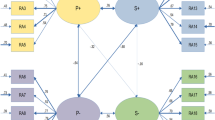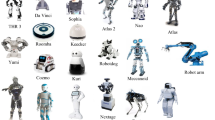Abstract
We examined how a revised presentation method of The Godspeed Scales affected results accruing from such tests which concern user judgments of anthropomorphism, animacy, likability, perceived intelligence, and perceived safety of robots. Through the use of Likert-type scales, rather than the original semantic- or bipolar-scale structure, we correlated results in order to determine which word pairs in the original scales were truly opposite in their meanings, where true opposites were anticipated to possess a strongly negative correlation. Results showed that individual differences in each participant’s baseline tendency to choose a rating exerted the strongest relationship with their overall scores. When those differences were accounted for the majority of the word-pairs used in the Godspeed Scale had negative correlations. These findings indicate that individual differences, rather than features of the robot per se, played the largest part in predicting how people will perceive any particular robot.


Similar content being viewed by others
Data Availability
Data is available upon request.
References
Bartneck C, Kulić D, Croft E, Zoghbi S (2009) Measurement instruments for the anthropomorphism, animacy, likeability, perceived intelligence, and perceived safety of robots. Int J Soc Robot 1(1):71–81
Bowling A, Windsor J (2008) The effects of question order and response-choice on self-rated health status in the English Longitudinal Study of Ageing (ELSA). J Epidemiol Community Health 62(1):81–85
Goetz J, Kiesler S, Powers A (2003) Matching robot appearance and behavior to tasks to improve human-robot cooperation. In: The 12th IEEE international workshop on robot and human interactive communication, 2003. Proceedings. ROMAN 2003. IEEE, pp 55–60
Ho CC, MacDorman KF (2010) Revisiting the uncanny valley theory: developing and validating an alternative to the Godspeed indices. Comput Hum Behav 26(6):1508–1518
Hancock PA, Billings DR, Schaefer KE, Chen JY, De Visser EJ, Parasuraman R (2011) A meta-analysis of factors affecting trust in human-robot interaction. Hum Factors 53(5):517–527
Hancock PA, Billings DR, Schaefer KE (2011) Can you trust your robot? Ergon Des 19(3):24–29
Hancock PA, Hancock GM, Warm JS (2009) Individuation: the N = 1 revolution. Theor Issues Ergon Sci 10(5):481–488
Hancock PA, Kessler TT, Kaplan AD, Brill JC, Szalma JL (2020) Evolving trust in robots: specification through sequential and comparative meta-analyses. Hum Factors
Hancock PA, Weaver JL, Parasuraman R (2002) Sans subjectivity, ergonomics is engineering. Ergonomics 45(14):991–994
Kamide H, Mae Y, Kawabe K, Shigemi S, Hirose M, Arai T (2012) New measurement of psychological safety for humanoid. In: 2012 7th ACM/IEEE international conference on human–robot interaction (HRI). IEEE, pp 49–56
Kaplan AD, Sanders T, Hancock PA (2019) The relationship between extroversion and the tendency to anthropomorphize robots: a bayesian analysis. Front Robot AI 5:135–140
McBride M, Morgan S (2010) Trust calibration for automated decision aids. Institute for homeland security solutions. [Online]. https://www.ihssnc.org/portals/0/Documents/VIMSDocuments/McBride_Research_Brief.pdf
Mori M (1970) Bukimi no tani [the uncanny valley]. Energy 7:33–35
Moshkina L (2012) Reusable semantic differential scales for measuring social response to robots. In: Proceedings of the workshop on performance metrics for intelligent systems, pp 89–94
Powers A, Kiesler S (2006) The advisor robot: tracing people’s mental model from a robot’s physical attributes. In: 1st ACM SIGCHI/SIGART conference on human–robot interaction, Salt Lake City, Utah, USA
Proctor RW, Cho YS (2006) Polarity correspondence: A general principle for performance of speeded binary classification tasks. Psychol Bull 132(3):416–442
Rothermund K, Wentura D (2004) Underlying processes in the implicit association test: dissociating salience from associations. J Exp Psychol Gen 133(2):139–165
Ruijten PA, Bouten DH, Rouschop DC, Ham J, Midden CJ (2014) Introducing a Rasch-type anthropomorphism scale. In: 2014 9th ACM/IEEE international conference on human–robot interaction (HRI). IEEE, pp 280–281
Schaefer KE, Chen JY, Szalma JL, Hancock PA (2016) A meta-analysis of factors influencing the development of trust in automation: Implications for understanding autonomy in future systems. Hum Factors 58(3):377–400
Weijters B, Geuens M, Schillewaert N (2010) The stability of individual response styles. Psychol Methods 15(1):96–110
Weiss A, Bartneck C (2015) Meta-analysis of the usage of the Godspeed questionnaire series. In: 2015 24th IEEE international symposium on robot and human interactive communication (RO-MAN). IEEE, pp 381–388
Zhang T, Kaber DB, Zhu B, Swangnetr M, Mosaly P, Hodge L (2010) Service robot feature design effects on user perceptions and emotional responses. Intel Serv Robot 3(2):73–88
Funding
No funding from any institution was supplied for this project.
Author information
Authors and Affiliations
Corresponding author
Ethics declarations
Conflict of interest
The authors declare that they have no conflict of interest.
Declarations
Approved for Public Release; Distribution Unlimited. Public Release Case Number 20-2369. The author's affiliation with The MITRE Corporation is provided for identification purposes only, and is not intended to convey or imply MITRE's concurrence with, or support for, the positions, opinions, or viewpoints expressed by the author. ©2020 The MITRE Corporation. ALL RIGHTS RESERVED.
Additional information
Publisher's Note
Springer Nature remains neutral with regard to jurisdictional claims in published maps and institutional affiliations.
Rights and permissions
About this article
Cite this article
Kaplan, A.D., Sanders, T.L. & Hancock, P.A. Likert or Not? How Using Likert Rather Than Biposlar Ratings Reveal Individual Difference Scores Using the Godspeed Scales. Int J of Soc Robotics 13, 1553–1562 (2021). https://doi.org/10.1007/s12369-020-00740-y
Accepted:
Published:
Issue Date:
DOI: https://doi.org/10.1007/s12369-020-00740-y




